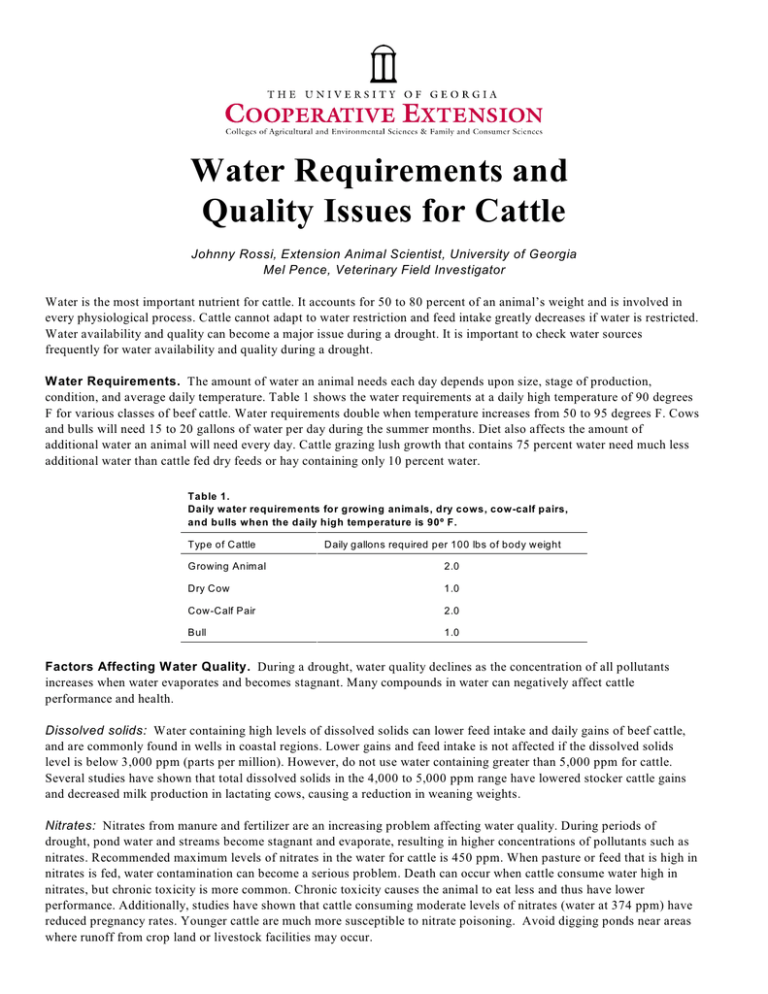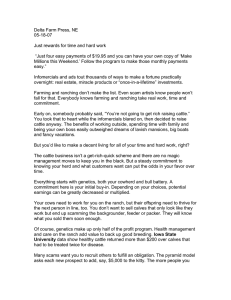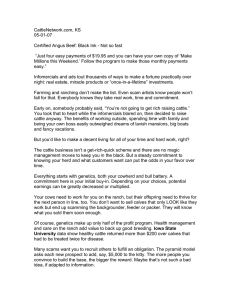Water Requirements and Quality Issues for Cattle
advertisement

Water Requirements and Quality Issues for Cattle Johnny Rossi, Extension Animal Scientist, University of Georgia Mel Pence, Veterinary Field Investigator Water is the most important nutrient for cattle. It accounts for 50 to 80 percent of an animal’s weight and is involved in every physiological process. Cattle cannot adapt to water restriction and feed intake greatly decreases if water is restricted. Water availability and quality can become a major issue during a drought. It is important to check water sources frequently for water availability and quality during a drought. Water Requirements. The amount of water an animal needs each day depends upon size, stage of production, condition, and average daily temperature. Table 1 shows the water requirements at a daily high temperature of 90 degrees F for various classes of beef cattle. Water requirements double when temperature increases from 50 to 95 degrees F. Cows and bulls will need 15 to 20 gallons of water per day during the summer months. Diet also affects the amount of additional water an animal will need every day. Cattle grazing lush growth that contains 75 percent water need much less additional water than cattle fed dry feeds or hay containing only 10 percent water. Table 1. Daily water requirements for growing anim als, dry cows, cow-calf pairs, and bulls when the daily high temperature is 90º F. Type of Cattle Daily gallons required per 100 lbs of body weight Growing Animal 2.0 Dry Cow 1.0 Cow-Calf Pair 2.0 Bull 1.0 Factors Affecting Water Quality. During a drought, water quality declines as the concentration of all pollutants increases when water evaporates and becomes stagnant. Many compounds in water can negatively affect cattle performance and health. Dissolved solids: Water containing high levels of dissolved solids can lower feed intake and daily gains of beef cattle, and are commonly found in wells in coastal regions. Lower gains and feed intake is not affected if the dissolved solids level is below 3,000 ppm (parts per million). However, do not use water containing greater than 5,000 ppm for cattle. Several studies have shown that total dissolved solids in the 4,000 to 5,000 ppm range have lowered stocker cattle gains and decreased milk production in lactating cows, causing a reduction in weaning weights. Nitrates: Nitrates from manure and fertilizer are an increasing problem affecting water quality. During periods of drought, pond water and streams become stagnant and evaporate, resulting in higher concentrations of pollutants such as nitrates. Recommended maximum levels of nitrates in the water for cattle is 450 ppm. When pasture or feed that is high in nitrates is fed, water contamination can become a serious problem. Death can occur when cattle consume water high in nitrates, but chronic toxicity is more common. Chronic toxicity causes the animal to eat less and thus have lower performance. Additionally, studies have shown that cattle consuming moderate levels of nitrates (water at 374 ppm) have reduced pregnancy rates. Younger cattle are much more susceptible to nitrate poisoning. Avoid digging ponds near areas where runoff from crop land or livestock facilities may occur. Mineral content: Other substances that produce water quality problems are sulfur, iron, and manganese. These minerals decrease water intake because of foul flavors and odor. Another common problem is excessive levels of minerals that interfere with normal mineral absorption and lead to deficiencies. This is most common with high iron and sulfate levels that bind and prevent the absorption of copper and zinc. Water temperature: Water temperature can also affect cattle performance. Cool water helps cattle maintain proper body temperature and leads to increased water intake. Shallow ponds or small water troughs can heat up in the summer and lead to decreased water intake. Deep ponds and groundwater pumped into large water tanks do not generally heat up enough to affect water intake. Algae: Blue-green algae is a water quality problem usually seen in surface water that is rich in nutrients. Blue-green algae are actually bacteria that, under the right conditions, can potentially produce toxins that can kill cattle. Toxicity problems usually occur when cattle consume large amounts of the algae in the summer or early fall following a rapid bloom of algae. The best method to control algae is to eliminate the source of nutrients entering the water, aerating the water, or fencing the cattle away from the pond and pumping water to a tank. If the intake pipe in the pond is at least 3 feet below the surface, intake of blue green algae toxins is minimal. Pond versus trough: Ponds are an important source of water for many cattle herds. To improve water quality in ponds, they may be fenced to prevent cattle gaining access, thereby reducing pond sedimentation. Reduce water consumption once the concentration of manure exceeds approximately 0.25 percent. There is conflicting research as to whether keeping cattle out of ponds improves animal health and performance. In one trial, stocker calf performance was compared when calves were offered water by 1) fresh water each day in a trough or 2) direct access to a pond. The study was repeated over 2 years. In year 1, calves that consumed pond water gained 20 percent less than calves that consumed fresh water. However, there was no difference in performance when the study was repeated in year 2. No difference in water intake or growth performance was noted in stocker calves or in nursing calves when the study was repeated using cow-calf pairs. Summary. Water is the most important nutrient for cattle, but providing clean water for cattle is often overlooked. Most problems will occur in the summer when pond water is contaminated with one of the anti-water quality factors such as manure, dissolved solids, nitrates, algae, or sulfates. Research is variable, but has shown weight gain increases up to 20 percent in calves provided water pumped into a tank versus calves drinking from a pond to which they had access. Poor water quality can lead not only to poor performance and poor reproduction that often goes unnoticed, but can be deadly as well. Special attention should be given to water quality during the hot summer months when most problems occur. Using the best quality of water available will contribute to the optimal production of cattle. Restricted water consumption of drinking water with high levels of nitrates, total dissolved solids, sulfates or other contaminants can affect production and reproduction. Drinking water quality should be part of an evaluation when there is a problem with poor cattle performance. The only way to be sure if a problem exists is to test the water for anti-quality factors. Contact the local county extension agent for sampling instructions and submission information. The University of Georgia and Ft. Valley State University, the U.S. Department of Agriculture and counties of the state cooperating. Cooperative Extension, the University of Georgia College of Agricultural and Environmental Sciences, offers educational programs, assistance and materials to all people without regard to race, color, national origin, age, gender or disability. An Equal Opportunity Employer/Affirm ative Action Organization Comm itted to a Diverse W ork Force SB-56 August 2007 Issued in furtherance of Cooperative Extension work, Acts of May 8 and June 30, 1914, The University of Georgia College of Agricultural and Environmental Sciences and the U.S. Department of Agriculture cooperating. J. Scott Angle, Dean and Director







